by Samuel Staples // Oct. 12, 2021
In his latest exhibition, his first solo show in Berlin since 2018, the Berlin-based, Swiss artist Julian-Jakob Kneer examines the self-mythologizing role of the artist, the construction of persona and the aesthetics of narcissism. The first impression we receive upon entering brunand brunand—the Kreuzberg gallery founded in 2021—is that of arriving in the aftermath of a performance. The remnants of a past event scatter the room: a pair of black leather steel-toe boots sit in front of a floor-length mirror, rows of black tailored suits hang on the walls, while a pair of gloves and various silk neckties rest in the room’s corners.
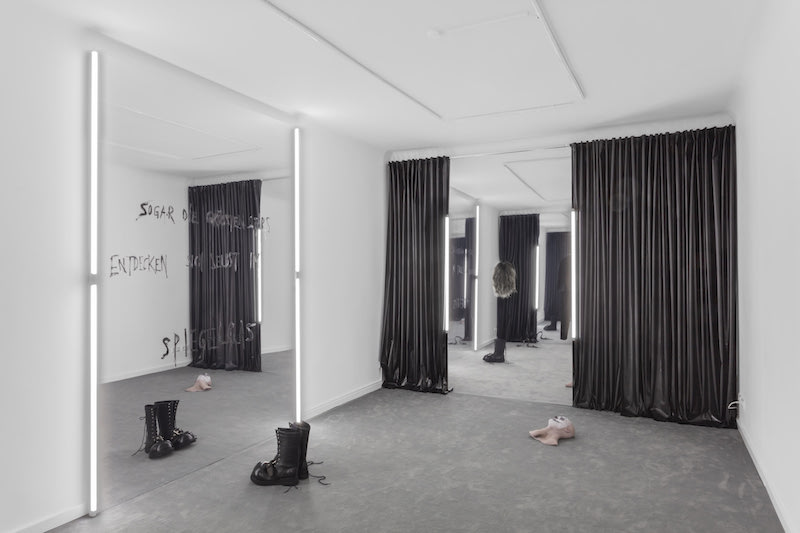
Julian-Jakob Kneer: ‘Sogar die grössten Stars entdecken sich selbst im Spiegelglas (Leben ihr Leben im Spiegelglas) / Madley / Lachen ist die schönste Art Zähne zu zeigen / Witness Me / Born to stand out / Decaydance / Sell the House Sell the Car Sell the Kids,’ 2021 // Courtesy of the artist and brunand brunand Berlin
We quickly realize these various objects are too perfect, too posed, too rigid to be authentic. The suits, though custom-tailored to Kneer’s body, have been further elongated. They appear boxy and clown-like. Similarly, the large-scale steel-toe combat boots (though customized to Kneer’s exact foot size from the interior) look oversized and cartoonish in proportion, resembling clown-shoes from the outside.
Elsewhere in the room, we peer down into the face of a custom made silicone mask that lies, curiously, on the gallery’s floor. The mask is a copy of Kneer’s own face, mixed with an algorithmically-generated-prototype-human and various celebrities, among them Heath Ledger and Joaquin Phoenix. The mask has been painted with makeup to resemble a clown.
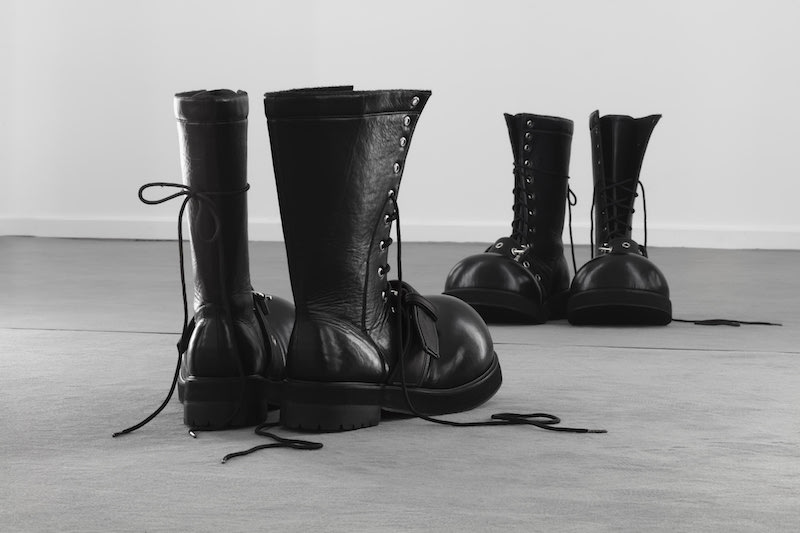
Julian-Jakob Kneer: ‘Sogar die grössten Stars entdecken sich selbst im Spiegelglas (Leben ihr Leben im Spiegelglas) / Madley / Lachen ist die schönste Art Zähne zu zeigen / Witness Me / Born to stand out / Decaydance / Sell the House Sell the Car Sell the Kids,’ 2021 // Courtesy of the artist and brunand brunand berlin
The exhibiting rooms are somewhere between stage and backstage. Large-scale, floor-length vanity mirrors cover three of the four walls, though these mirrors are out of proportion, too wide to be flattering. The fluorescent light tubes on each mirror’s side are harsh, white and cold, washing us out, and resulting in a twisted perspective and self-image, as if in a funhouse. “It is stage and backstage: a Kammerspiel / a performance for one. I’m inviting the viewer to confront themselves on that stage of self,” Kneer tells me.
Kneer’s work oscillates between various moral and aesthetic binaries of ‘high’ and ‘low,’ ‘good’ and ‘bad’ taste, desire and repulsion, love and fear, ‘right’ and ‘wrong.’ Kneer has long explored these juxtapositions of apparent opposites in his work, typically with a sense of ambiguity and distance, but here things feel more personal, more intimate than in previous works.
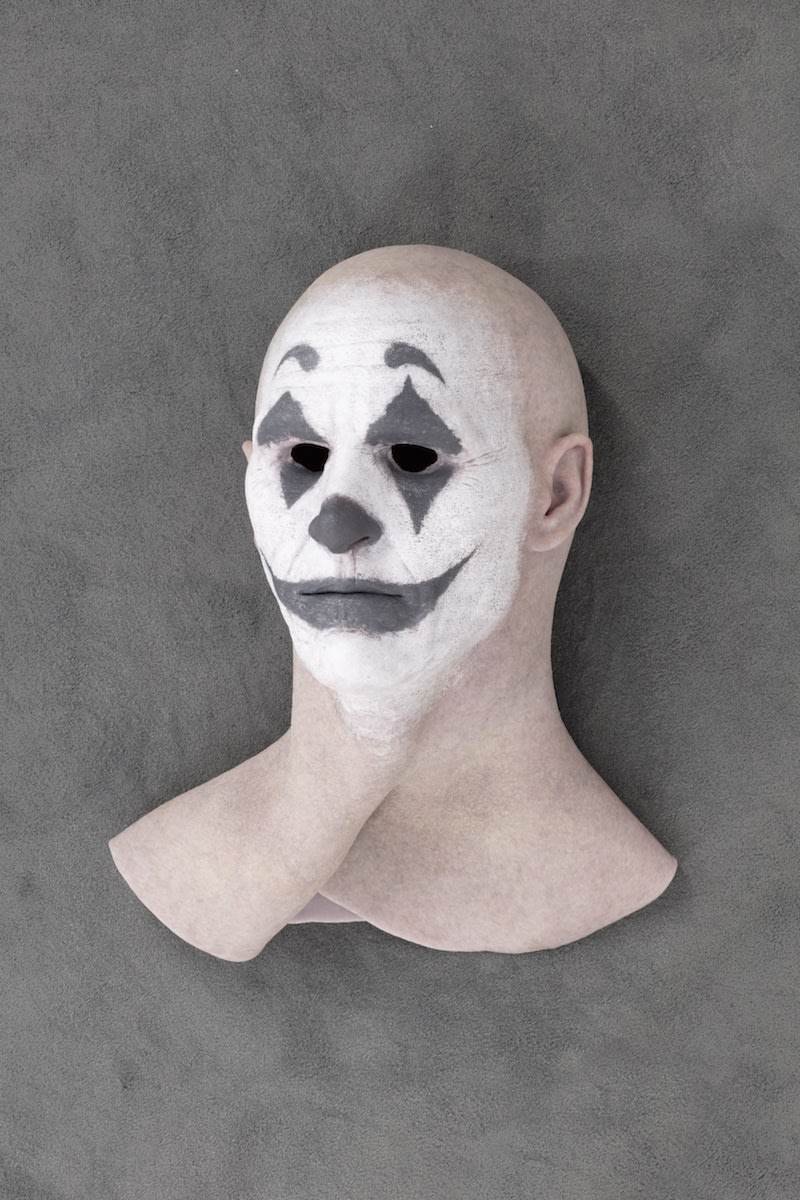
Julian-Jakob Kneer: ‘Sogar die grössten Stars entdecken sich selbst im Spiegelglas (Leben ihr Leben im Spiegelglas) / Madley / Lachen ist die schönste Art Zähne zu zeigen / Witness Me / Born to stand out / Decaydance / Sell the House Sell the Car Sell the Kids,’ 2021 // Courtesy of the artist and brunand brunand berlin
A certain ambivalence and sense of mystery are central to Kneer’s artistic practice: ambiguity over explanation, asking questions instead of giving answers. Earlier this year, as part of Schinkel Pavillon’s drone-led video series ‘High-Rise Berlin,’ Kneer granted viewers an insight into his studio practice. Many of the current exhibition’s works feature in the video in various stages of development, but the studio visit curiously features no dialogue from the artist himself. The film begins with a monologue by Lana Del Rey from her 2012 music video Ride, though here her voice is altered, skewed nearly beyond recognition. “Are you in touch with all of your darkest fantasies?” she asks. “Have you created a life for yourself where you can experience them? I have. I am fucking crazy. But I am free.” We follow a shadowy figure in black into a fluorescent lit studio, cans of redbull scatter the window sills, the figure smokes a cigarette, and applies white makeup to their neck and face (conveniently left out of frame). The film ends with our antihero looking out at the night sky view of Berlin from the building’s roof, their back turned to the camera. It’s an image that wouldn’t look out of place in a major motion-picture.
Absent from the exhibition is an exhibition text, at least in the traditional sense, instead we receive a sheet of various lyrics from pop songs. “Lana / Twigs / Bieber / Gaga / Spears say it best,” Kneer writes. References to popular culture, music and films are not uncommon in Kneer’s work; references to ‘low’ culture are often used as a device by the artist to reveal his own personal experiences, intimacy revealed through ambiguity. Kneer baptizes the show with 7 titles; the individual pieces interchangeably bear each and every of the 7 titles of the show.
Lyrics are similarly scrawled in black lipstick across the mirrors. ‘Sogar die grössten Stars entdecken sich selbst im Spiegelglas,’ reads one. It’s a lyric from Kraftwerk’s 1977 song ‘Spiegelsaal’ (The Hall of Mirrors), translated as, “Even the greatest stars discover themselves in the looking glass.”
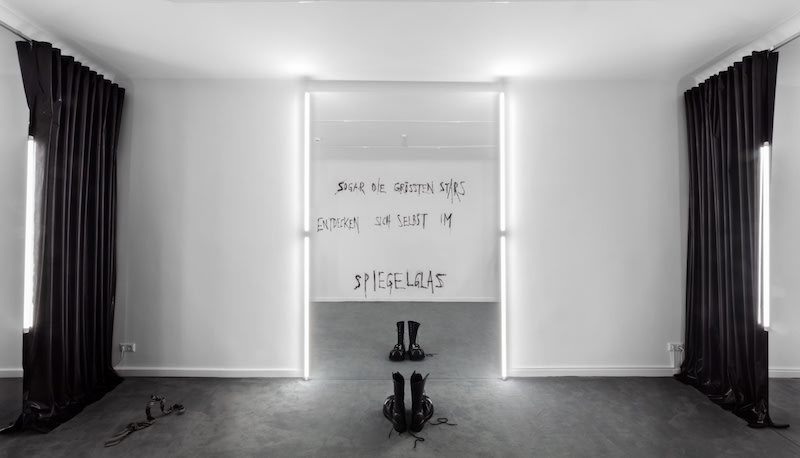
Julian-Jakob Kneer: ‘Sogar die grössten Stars entdecken sich selbst im Spiegelglas (Leben ihr Leben im Spiegelglas) / Madley / Lachen ist die schönste Art Zähne zu zeigen / Witness Me / Born to stand out / Decaydance / Sell the House Sell the Car Sell the Kids,’ 2021 // Courtesy of the artist and brunand brunand berlin
‘Lachen ist die schönste Art Zähne zu zeigen,’ reads another, loosely translated it means: “Smiling / Laughter is the best way to bear one’s teeth.” A recurring figure that looms over much of Kneer’s work is that of the Joker, particularly the 2008 accelerationist portrayal of the character by actor Heath Ledger in Christopher Nolan’s ‘The Dark Knight.’ Kneer is particularly interested in these “allegedly” tragic archetypal figures in his work, the antiheroes, the outcasts, loners and losers. ‘Why fit in when you were born to stand out’ is a title he repeatedly uses in his work, and in this show as well. Ledger famously died during post-production of the film (which would be his final role), a fate which has led to a sort of martyrdom and mythologization of the actor in the years following. It has been alleged that Ledger, who overdosed on a combination of sleeping pills, couldn’t get out of his art, and that it was the role that ultimately consumed him. Affiliates stated that some of the Joker character bled into Ledger irreversibly during and after shooting the film.
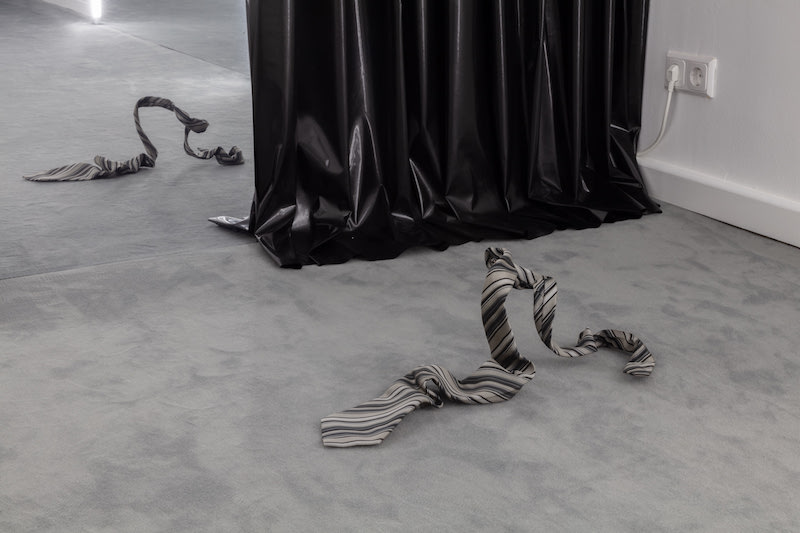
Julian-Jakob Kneer: ‘Sogar die grössten Stars entdecken sich selbst im Spiegelglas (Leben ihr Leben im Spiegelglas) / Madley / Lachen ist die schönste Art Zähne zu zeigen / Witness Me / Born to stand out / Decaydance / Sell the House Sell the Car Sell the Kids,’ 2021 // Courtesy of the artist and brunand brunand berlin
The Joker character represents to Kneer a duality that everyone has within them, one of extremes. “The exhibition is as much a self-portrait of me as it is of everyone else,” Kneer tells me. “A self-portrait as the Joker. The Joker as something present in all of us, not as a character, but rather an avatar. The Joker is something present in our daily lives, a fifth season, a floating signifier, a drug, an omnipresent chaos factor. A medium to mirror an unbiased reality without prejudice.”
There’s a scene towards the end of the 2008 film when the Joker visits Harvey Dent in the hospital, he has just killed Dent’s girlfriend and left him badly disfigured in a game of chance. The Joker hands Dent a gun, the choice belongs to Dent: kill the Joker, kill himself, do nothing. “Upset the established order and everything becomes chaos. I’m an agent of chaos. Oh, and you know the thing about chaos? It’s fair,” he tells him. “The Joker does not take actions, but rather offers possibilities, asks questions and questions what is right,” Kneer tells me. “I feel that is what art should do.”
Exhibition Info
brunand brunand
Julian-Jakob Kneer
Exhibition: Sept. 11–Oct. 23, 2021
brunandbrunand.com
Eisenbahnstraße 4, 10997 Berlin, click here for map
Video Info
Julian-Jakob Kneer for Schinkel Pavillon High Rise Berlin, 2021
Courtesy of the artist and Schinkel Pavillon. Video HD, stereo sound 04:40
Concept by Schinkel Pavillon and Malina Heinemann
Camera: Joseph Kadow
Post-production: Joseph Kadow & Julian-Jakob Kneer
Sound: Julian-Jakob Kneer in collaboration with Emma Czerny
Thanks to Dushan Petrovich and Fritz Schiffers






















